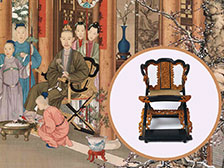
Here be dragons:
Emperor Qianlong’s magnificent folding chair (inset) is shown in the painting, Hongli Enjoying Himself on a Snowy Day, which depicts the noble admiring the snow with his sons at the palace.
Here be dragons:
Emperor Qianlong’s magnificent folding chair (inset) is shown in the painting, Hongli Enjoying Himself on a Snowy Day, which depicts the noble admiring the snow with his sons at the palace.
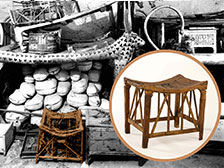
Ancient craft:
One of the chairs on exhibit is a stool dating back more than 3,000 years (inset). Similar stools were also discovered in King Tutankhamun’s tomb.
Ancient craft:
One of the chairs on exhibit is a stool dating back more than 3,000 years (inset). Similar stools were also discovered in King Tutankhamun’s tomb.
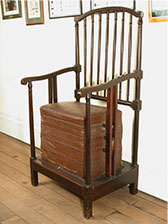
Giddyap!:
This chamber horse is made of leather-bound layers of wooden boards and springs. Users gripped its arms and simulated horse-riding action.
Giddyap!:
This chamber horse is made of leather-bound layers of wooden boards and springs. Users gripped its arms and simulated horse-riding action.
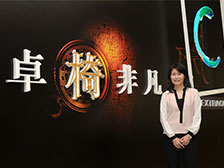
Extraordinary display:
Hong Kong Heritage Museum Curator Naomi Szeto hopes people will pay more attention to not only chairs, but to other ‘ordinary’ things in our daily life.
Extraordinary display:
Hong Kong Heritage Museum Curator Naomi Szeto hopes people will pay more attention to not only chairs, but to other ‘ordinary’ things in our daily life.
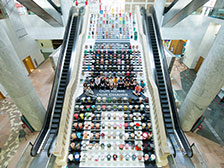
Four-legged creations:
Local design students created 300 chairs for an eye-popping display in the museum lobby.
Four-legged creations:
Local design students created 300 chairs for an eye-popping display in the museum lobby.
Museum opens sit-down celebration
June 22, 2014
Chairs are part of everyday life, yet we seldom give them a second thought. A new Hong Kong Heritage Museum exhibition, The Extraordinary in the Ordinary: Chairs for Viewing the World through Time, tells the story of more than 130 chairs, to help visitors to see they really are more than part of the furniture.
Civilsations welcomed chairs throughout the ages. “Never stand up when you can sit down,” former UK Prime Minister Winston Churchill wisely stated. “Please have a seat” are the words spoken after “hello” when Chinese people serve their guests.
The earliest surviving examples of chairs come from ancient Egypt where they were designed to seat royalty and the elite. One of the chairs on exhibit is a stool dating back more than 3,000 years, from the period of King Tutankhamun (1539-1295 B.C.), the boy pharaoh of the18th dynasty.
The lattice stool has a curved seat which adapts to the human body. Despite its old age, it is in good condition. Similar stools, in terms of size, build or design, were also discovered in King Tutankhamun’s tomb.
Reserved seating
Folding chairs are common in modern times, but were designed for nobles in the early Qing dynasty. Their use in the royal court was a status symbol. The Black Lacquered Folding Chair with Cloud & Dragon Design in Gold reflects Emperor Qianlong’s power and prestige.
The two arms, ending in dragonheads, join the rounded back of the throne to form two meandering dragons and five mountain peaks.
“We found the painting, Hongli Enjoying Himself on a Snowy Day, which depicts Emperor Qianlong admiring the snow with his sons at the palace over the new year - and he was sitting on this chair,” museum Curator Naomi Szeto said.
While some chairs were valuable and reserved for nobles, chairs commoners used were designed for other practical uses, including chairs that helped women in childbirth, others that could measure a child’s weight, and even ones for exercising.
Wealthy Europeans enjoyed horse riding in the 18th century. When the weather became too extreme for outdoor exercise in winter, they mounted a chamber horse. Its seat was made of leather-bound layers of wooden boards and springs. Users gripped its arms and simulated horse-riding action.
The chairs on show are on loan from world-class museums from across the world including Beijing’s Palace Museum, New York’s Brooklyn Museum, Austria’s Vienna Furniture Museum Imperial Furniture Collection, the UK’s Shakespeare Birthplace Trust, and the British Museum.
The exhibition showcases contemporary creative designs, also. Students from the Design Institute and the Institute of Vocational Education (Lee Wai Lee) created 300 chairs for an eye-popping display in the museum lobby.
“We sit on chairs every day, without giving them much thought,” Curator Ms Szeto said.
“After visiting this exhibition, I hope people will pay more attention to not only chairs, but to other ‘ordinary’ things in our daily life. They might just discover something extraordinary.”
The exhibition is at the Heritage Museum until September 15. Click here for details.